Italian Sourdough Starter – Lievito Madre Recipe
Italian Sourdough Starter – Lievito Madre Recipe is made a little bit different then the more well known version. This is a lower hydration starter which also takes longer to produce. But it is well worth it.

So after making a Sourdough Starter that most of us usually use, I decided that I wanted to also give the Italian version, Lievito Madre a try. A friend explained how it is made and here is the result. Time is needed but it is very easy and straight forward.
How to make it
Step 1
In a small bowl mix together the lukewarm water and honey, then add the flour and make a non sticky dough ball

Mark with a cross. Then place in a large glass jar, place lid on top but do not close. Let sit in a warm draft free area for 48 hours.

Step 2
Remove 100 grams of the dough, it’s best to remove the top part of the dough which tends to be dry, then keep 100 grams of the remaining dough (discard anything over the 100 grams), place in a bowl and add the flour and water, knead to form a compact dough, make a cross. Place in the jar (which has been cleaned, rinsed well and dried). Cover lightly and let rest again for 48 hours.
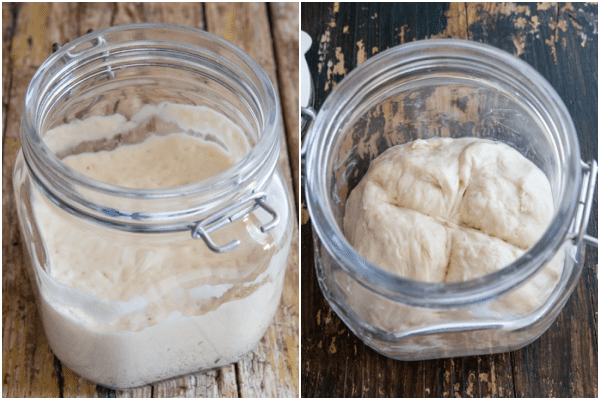
Step 3
Remove 100 grams of the dough, it’s best to remove the top part of the dough which tends to be dry, then keep 100 grams of the remaining dough (discard anything over the 100 grams), place in a bowl and add the flour and water, knead to form a compact dough, make a cross. Place in the jar (which has been cleaned, rinsed well and dried). Cover lightly and let rest again for 48 hours.

Step 4
Remove 100 grams of the dough, it’s best to remove the top part of the dough which tends to be dry, then keep 100 grams of the remaining dough (discard anything over the 100 grams), place in a bowl and add the flour and water, knead to form a compact dough, make a cross. Place in the jar (which has been cleaned, rinsed well and dried). Cover lightly and let rest again for 48 hours.
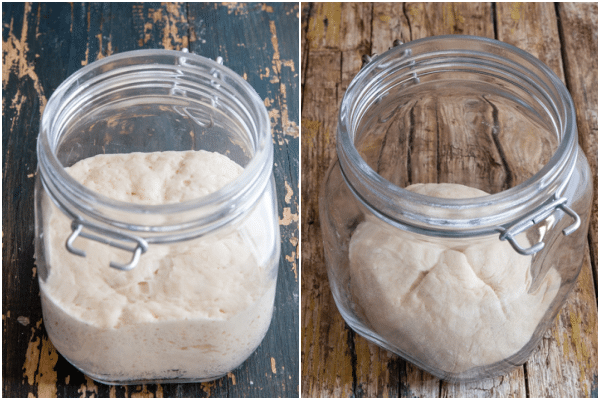
Step 5
Remove 100 grams of the dough, it’s best to remove the top part of the dough which tends to be dry, then keep 100 grams of the remaining dough (discard anything over the 100 grams), place in a bowl and add the flour and water, knead to form a compact dough, make a cross. Place in the jar (which has been cleaned, rinsed well and dried). Cover lightly and let rest again for 24 hours.
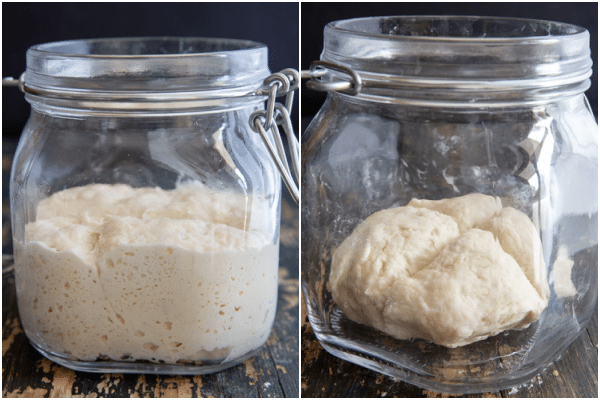
Step 6
Again remove 100 grams of the dough, it’s best to remove the top dry part of the dough, then keep 100 grams of the remaining dough (discard anything over the 100 grams), place in a bowl and add the flour and water, knead to form a compact dough, make a cross. Place in the jar (which has been cleaned, rinsed well and dried). Cover lightly and let rest again for 24 hours.
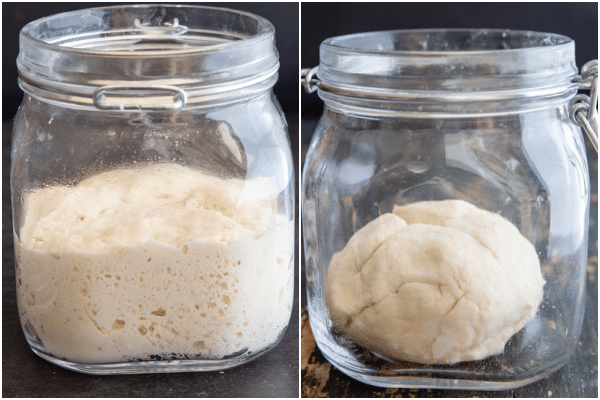
Step 7
Again remove 100 grams of the dough, it’s best to remove the top dry part of the dough, then keep 100 grams of the remaining dough (discard anything over the 100 grams), place in a bowl and add the flour and water, knead to form a compact dough, make a cross. Place in the jar (which has been cleaned, rinsed well and dried). Cover lightly and let rest again for 24 hours.
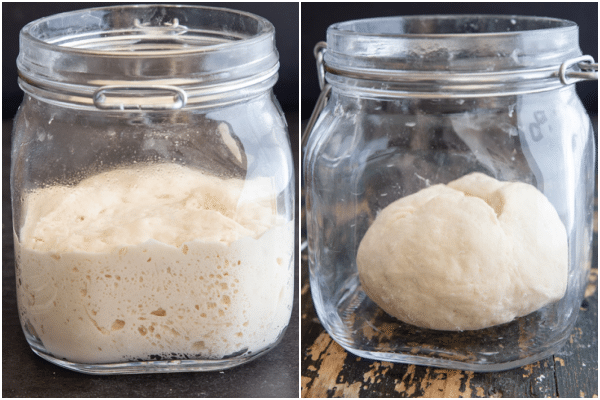
Step 8
Again remove 100 grams of the dough, it’s best to remove the top dry part of the dough, then keep 100 grams of the remaining dough (discard anything over the 100 grams), place in a bowl and add the flour and water, knead to form a compact dough, make a cross. Place in the jar (which has been cleaned, rinsed well and dried). Cover lightly and let rest again for 24 hours.
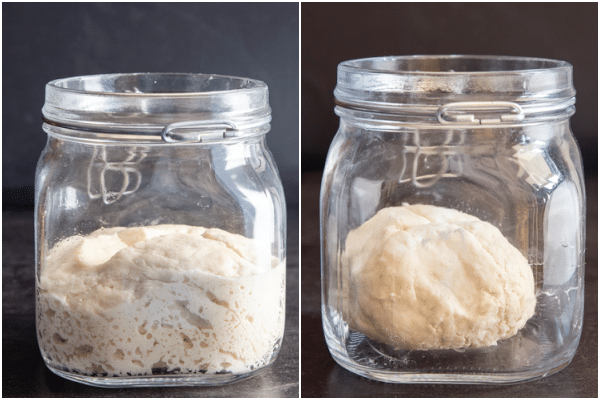
Step 9
Again remove 100 grams of the dough, it’s best to remove the top part of the dough, then keep 100 grams of the remaining dough (discard anything over the 100 grams), (from today on discard can be used for baking), place in a bowl and add the flour and water, knead to form a compact dough, make a cross. Place in the jar (which has been cleaned, rinsed well and dried). Cover lightly and let rest again for 24 hours.
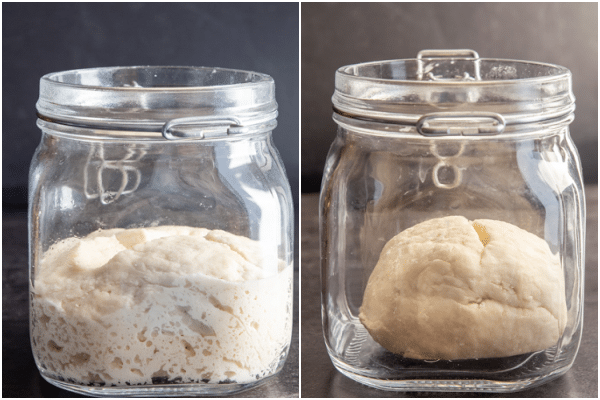
Step 10
Again remove 100 grams of the dough, it’s best to remove the top dry part of the dough, then keep 100 grams of the remaining dough (discard anything over the 100 grams), place in a bowl and add the flour and water, knead to form a compact dough, make a cross. Place in the jar (which has been cleaned, rinsed well and dried). Cover lightly and let rest again for 24 hours.
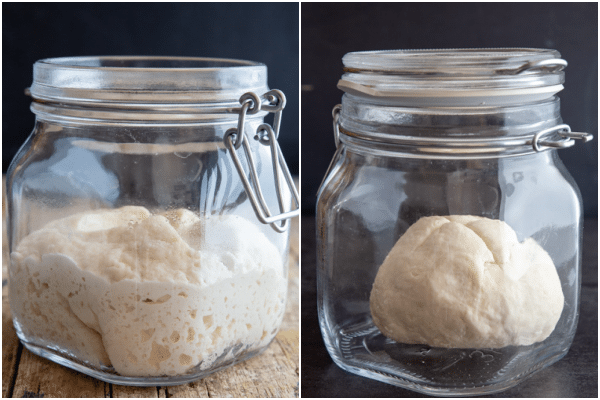
Step 11
Again remove 100 grams of the dough, it’s best to remove the top dry part of the dough, then keep 100 grams of the remaining dough (discard anything over the 100 grams), place in a bowl and add the flour and water, knead to form a compact dough, make a cross. Place in the jar (which has been cleaned, rinsed well and dried). Cover lightly and let rest again for 24 hours.

Step 12
Ready to use!

The few days you probably won’t notice much difference in growth but the yeast will be stronger.
What is the best jar to use?
The best jar to use is a glass jar with a lid, it’s best to have one that is large enough that you can stick your hand in.
Why is a Natural Starter a better choice?
A natural starter or sourdough starter gives a more intense flavour to your bread recipe. You will also have a better developed crumb, which helps the bread to grow in height rather than width. It also has a better shelf life, this is because of the level of acidity of the dough which tends to inhibit most of the moulds, it also keeps its aroma for a longer period and has a more appealing crust colour.
Some people find (me included) that it is easier to digest because of the the transformation of the more complex substances into simpler ones, therefore it makes it easier for our bodies to absorb.
What equipment do you need?
To get everything set up to start, you are going to need, a good quality all purpose or bread flour (unbleached), chlorine free water (bottled or filtered), a scale – because I think working in grams is best for bread, a thermometer, a large jar with a lid.
Why make a cross in the dough?
The cross, according to popular superstition, was used to bless the dough of bread and to drive out demons or evil forces that would have hindered the leavening. In fact, it is said that having received from the Pope, the order to bless the loaves, Saint Clare made the sign of the cross on them. So a little Italian superstition never hurt!
What is the best room temperature for the starter?
The starter should be kept in a warmish room, the best temperature would be anywhere from 70-85F (21-30C).
What are some of the differences between the two starters?
- Lievito Madre is a much firmer starter, more like a dough.
- There will be no liquid (hooch) produced this way.
- I find the aroma is not as strong.
Why is the starter dough discarded?
The starter is discarded so that there is less flour needed to maintain it. If you just added the same amount of flour each time you refresh the stater (without removing any starter), you would eventually come to a point where the added flour is not enough to refresh the starter and it would starve.
The starter is not a real starter until you have arrived at about step 9 or 10 and sometimes longer. It takes time for the organism balance to get established.
What to make with discarded starter
Lots of people, me included would rather not throw away food, (but unfortunately you will have to eliminate some of that starter at the beginning), and that goes for discarded starter, here are a few ideas that you can use with it. A fast and simple one is frying it, sprinkle with your favourite spices and fry in some oil. You could share it with friends once it is developed.
I started to use the discard after day 10, or you could refrigerate it and keep adding the discard until you have enough for a recipe (recipes to follow). It will last up to 2-3 months in the fridge.
What to do when the starter is active
Once the starter is active the first thing to do is give it a name, yes people name their starters. Then you can refrigerate the starter especially if you plan on baking bread about once a week. If you plan on baking everyday then the starter should be kept on the counter. And fed once a day.
How to store the Lievito Madre
Store it in a clean glass or another container that is suitable for food, it should be at least three times larger than the starter. Do not close it tightly, leave it in the refrigerator until the next use, remember to refresh it every 5-7 days at the most if not using.
How to refresh the starter
Remove the starter from the refrigerator and leave it at room temperature for an hour , if your house is cooler then extend the time to about 2 hours. Eliminate the top layer of the dough, which may be dry and crusty. Remove 100 grams, add 50 grams of water and 105 grams of flour. knead the dough until you get a compact dough.
Engrave a cross on the dough and place it in the clean glass jar. Let it sit at room temperature until it has doubled (3-4 hours) then place it back in the fridge.
How to bake with a refrigerated starter
When you want to use the starter, it must be refreshed, a part will then be used and a part will be kept in the refrigerator for subsequent uses. To refresh the starter for use, proceed in this way.
Remove the starter from the refrigerator and leave it at room temperature for an hour or two (it also depends on the warmth of your room). Sometimes an extra hour is needed.
If needed remove the top layer of the dough (the dry part), weigh the dough, and feed with the same amount of flour (for example if it weighs 100 grams I feed with 100 grams of flour, I sometimes use 70 grams bread and 30 grams whole wheat), and about half the amount of water (so it would be 45-50 grams of water lukewarm) and 1/4 teaspoon of honey. Honey will help the starter react.
Mix it all together, when it is almost combined move it to a very lightly floured flat surface and knead the dough until a compact dough is obtained. Mark the dough with a cross and place in a clean wide mouthed jar, cover with plastic and let rise until doubled, which usually takes 3-4 hours, lievito madre likes a temperature between 71-77F (22-25C). You can also brush the dough very lightly with olive oil to help prevent a crust from forming.
Using refrigerated starter, you will need to repeat the feeding 1-3 times to produce an active enough starter, this all depends on the temperature of your home and how many days it hasn’t been fed. Any discard can be used in recipes. Discard will keep in the fridge for a couple of days.
Recipes with Lievito Madre
If you decide to try this Italian Sour Dough Starter – Lievito Madre Recipe, I hope you enjoy it and let me know how it goes. Enjoy!
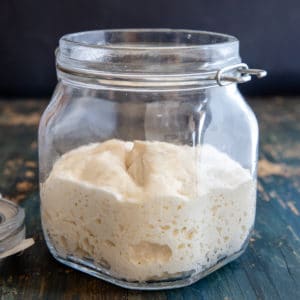
Italian Sour Dough Starter – Lievito Madre Recipe
Ingredients
STEP 1
- 105 grams all purpose or bread flour (unbleached) (¾ cup + 1 tablespoon)
- 50 grams water lukewarm chlorine free water (85F/40C) (3⅓ tablespoons)
- 1/2 teaspoon honey
STEP 2 -11
- 105 grams all purpose or bread flour (unbleached)
- 50 grams water lukewarm chlorine free water (85F/40C)
Instructions
STEP 1
- In a small bowl mix together the lukewarm water and honey, then add the flour and make a non sticky dough ball. Mark with a cross. Then place in a large glass jar, place lid on top but do not close. Let sit in a warm draft free area for 48 hours.
STEP 2
- Remove 100 grams of the dough, it's best to remove the top dry part of the dough, then keep 100 grams of the remaining dough (discard anything over the 100 grams), place in a bowl and add the flour and water, knead to form a compact dough, make a cross. Place in the jar (which has been cleaned, rinsed well and dried). Cover lightly and let rest again for 48 hours.
STEP 3
- Again remove 100 grams of the dough, it's best to remove the top dry part of the dough, then keep 100 grams of the remaining dough (discard anything over the 100 grams) place in a bowl and add the flour and water, knead to form a compact dough, make a cross. Place in the jar (which has been cleaned, rinsed well and dried). Cover lightly and let rest again for 48 hours.
STEP 4
- Again remove 100 grams of the dough, it's best to remove the top dry part of the dough, then keep 100 grams of the remaining dough (discard anything over the 100 grams), place in a bowl and add the flour and water, knead to form a compact dough, make a cross. Place in the jar (which has been cleaned, rinsed well and dried). Cover lightly and let rest again for 48 hours.
STEP 5
- Again remove 100 grams of the dough, it's best to remove the top part of the dough, then keep 100 grams of the remaining dough (discard anything over the 100 grams), place in a bowl and add the flour and water, knead to form a compact dough, make a cross. Place in the jar (which has been cleaned, rinsed well and dried). Cover lightly and let rest again for 24 hours.
STEP 6
- Again remove 100 grams of the dough, it's best to remove the top part of the dough, then keep 100 grams of the remaining dough (discard anything over the 100 grams), place in a bowl and add the flour and water, knead to form a compact dough, make a cross. Place in the jar (which has been cleaned, rinsed well and dried). Cover lightly and let rest again for 24 hours.
STEP 7
- Again remove 100 grams of the dough, it's best to remove the top part of the dough, then keep 100 grams of the remaining dough (discard anything over the 100 grams), place in a bowl and add the flour and water, knead to form a compact dough, make a cross. Place in the jar (which has been cleaned, rinsed well and dried). Cover lightly and let rest again for 24 hours.
STEP 8
- Again remove 100 grams of the dough, it's best to remove the top part of the dough, then keep 100 grams of the remaining dough (discard anything over the 100 grams), place in a bowl and add the flour and water, knead to form a compact dough, make a cross. Place in the jar (which has been cleaned, rinsed well and dried). Cover lightly and let rest again for 24 hours.
STEP 9
- Again remove 100 grams of the dough, it's best to remove the top part of the dough, then keep 100 grams of the remaining dough (discard anything over the 100 grams), place in a bowl and add the flour and water, knead to form a compact dough, make a cross. Place in the jar (which has been cleaned, rinsed well and dried). Cover lightly and let rest again for 24 hours.
STEP 10
- Again remove 100 grams of the dough, it's best to remove the top part of the dough, then keep 100 grams of the remaining dough (discard anything over the 100 grams), place in a bowl and add the flour and water, knead to form a compact dough, make a cross. Place in the jar (which has been cleaned, rinsed well and dried). Cover lightly and let rest again for 24 hours.
STEP 11
- Again remove 100 grams of the dough, it's best to remove the top part of the dough, then keep 100 grams of the remaining dough (discard anything over the 100 grams), place in a bowl and add the flour and water, knead to form a compact dough, make a cross. Place in the jar (which has been cleaned, rinsed well and dried). Cover lightly and let rest again for 24 hours.
STEP 12
- Ready to use!
Hi Rosemary
Finally at Step 12.
Now if I want to make a bread, thus is what I understand:
Take 100gm of the starter and I can follow the recipe for the Rustic Bread.
What do I do with the leftover starter? Can I keep it the way it is for the next time I make bread? Or do I have to feed it like I did with the starter?
Hi Ersilia, you should fee the starter, next time you use it, remove 100 grams and fee that the remaining if you make bread often then you can you it to make recipes with unfed starter or also called leftover starter dough recipes. Hope that helps. Take care. Let me know how it comes out.
Hi, in the first step you indicate to take 100 grams of flour and then after 48 hours select 100 grams and again add 100 grams of flour and water to the remaining 100 grams of dough. Are you okay with the math or the recipe?
Hi Tamazi, yes I am, I actually say to remove 100 grams of the dough, it’s best to remove the top part of the dough which tends to be dry, then keep 100 grams of the remaining dough (discard anything over the 100 grams), I don’t understand what you are saying.
Hi – if you use Einkorn flour for the starter would you need to adjust the recipe?
Hi Joanne, you may need about 15-20% less water, so going by the photos start with less water and add a bit more if needed. Let me know how it goes. Take care!
Hi Rosemary, just getting started with the starter. On step 2 , however, my dough looks the same as when I placed it in the jar to begin with. No bubbles or rising of any kind… will that come later or did I do something wrong?
Hi Pam, yes it will take a bit for the starter to start bubbling. Let me know!
I have had my LV going for the past few months and was wondering about making cinnamon buns with it. Is there a recipe for it that you know of or some formula for substituting higher hydration sour doughs with LV. I prefer the much milder taste with sweet breads.
Hi Cathy, I really don’t have one for LM but what I would do is use a regular sourdough recipe if you check theclevercarrot.com she is very good for sourdough starter dough recipes, the only thing that you will have to do is increase the liquid a bit for the recipes. Some say 1/3 extra of liquid, but you might want to start with less and add more if needed to reach the type of dough necessary. I hope that helps. Let me know. Take care.
Hi! How do I keep some of future use? Do I need to feed 1x day forever or how to I save to use once a week? Thanks!
Hi Gia, you can feed it once a week, but you may need to feed it more than once when you do want to use it. 🙂
Hi Rosemary 😊
What a wonderful recipe. So we’ll explained and thorough. I want to make the LM to make panettone. The only obstacle for me is the waste. With my sourdough I use the discard to make pancakes or waffles so there’s no waste. Are there other things I can do with the discard from LM? Thanks in advance. Chris
Hi Chris, if you go to https://breadsandsweets.com/ , it was my 2nd site and is now my daughter’s and search discard, there are a few recipes, including biscuits, focaccia, pie crust and Lemon ricotta cookies (maybe a couple more), it does use regular sourdough discard, but just add a bit more liquid. Hope that helps. Let me know. Take care!
Hi I’m on step 10 and the dough is always very sticky , don’t know how to explain it. is this normal. I don’t want to use it to make a panettone if it didn’t come out right
Hi Filomena, if it’s very sticky (does it look like the pictures?), add a bit more flour, if it’s active and bubbly it should be fine. Let me know.
Just confirming. You feed: 100g starter, 105g flour, and 50g water?
Hi Aimee, yes that is correct. Take care!
So I made a mistake and followed the directions and fed mine every 48 hours instead of switching to 24 at a certain point. Does that mean I need to feed mine every 24 hours for a while or do you think it’s still ready to use?
Hi Aimee, if it has doubled and grown and there are lots of bubbles, then yes it should be ready, if not you could feed it again just to strengthen it. Let me know. Take care!
So when you feed LM, you don’t add honey each feeding?
Hi Aimee, no I don’t honey. 🙂
Hi Rosemary,
I made panettone using Giorilli’s panettone recipe with your LM. It worked beautifully! My next project is making Bialys. The recipe i have is a scaled down version of Kossar’s in NYC. The recipe calls for 1/2 oz of fresh bakers yeast, which is difficult to find these days! Do you think I could substitute your LM for the yeast? If so, how much of the LM would equal 1/2 oz of the bakers yeast? Thanks for all your help!!
Chuck
Hi Chuck, that’s great, so glad it turned out so well. So these amounts are interchangeable 5-7 grams of dry yeast / 12-15 grams of fresh yeast / 100 grams of sourdough starter. Be sure to adjust for water and flour if using sourdough starter. So for example if your 100 grams of sourdough starter uses 50 grams of water and 50 grams of flour then use 50 grams of water and 50 grams of water less in the recipe. Let me know if this makes sense. 🙂 So 1/2 ounce of bakers yeast would equal 14 grams which would be 100 grams of starter.
Hi Rosemary,
I have made the LM following your recipe and it has gone beautifully! I want to store it in the fridge. Do I do the normal daily refreshment and then put it in the fridge or do I wait awhile after the refreshment and then put it in the fridge? I hope to make panettone this week. I will let you know how that goes. Thanks for all your help!
Chuck
Hi Chuck, you should wait a couple of hours until it has risen and then refrigerate. When you take it from the fridge, let it sit for about 30 minutes then refresh. Glad I could help. Let me know how it goes. Take care!
Thanks for such a complete and thorough recipe for LM.
I want to try making panettone for the first time. I’m not very familiar with sourdough starters, but I do know that here in San Francisco, CA the air contains a unique form of yeast. Would the resulting LM be too sour if I simply use SF air, or should I initiate the process using a commercially available dry yeast ?
Thanks !
Hi William, you’re welcome, lucky you I have heard San Francisco has one of the best sourdough starters available. I would try it with that, I imagine it would be amazing. I actually have a sourdough starter that using a bit of yeast to start it you could check that out. https://breadsandsweets.com/sourdough-starter-with-yeast/ . Let me know. You have piqued my interest, I may give it go this year too! 🙂
Hi Rosemary, I would like to use your LM to make panettone. The recipe I use calls for refreshing the levain/starter 3 times in one day throughout morning and afternoon (example, 8AM, noon, and 3PM), and then make first panettone dough in evening at 8PM. Would you please walk me through this 3 refreshment process? How much flour,water and LM do I use for each refreshment? Is your LM a 100% hydration or a 45% hydration? Thank you for your help!
Hi Chuck, well it depends on how much starter you need for the recipe. So I am looking at one that says the same as yours, it calls for 125 grams of LV, I would stick to 100 grams and refresh it with 50 grams of water and 105 grams of flour, knead the dough until you get a compact dough. Do that 3x with only 100 grams, then remove however much you need for the recipe, the rest, refrigerate. The discard you could make chocolate chip cookies – https://anitalianinmykitchen.com/lievito-madre-chocolate-chip-cookies/. Or something else you find. Lievito madre is around 50% hydration. Let me know how it goes or if you have anymore questions. Take care!